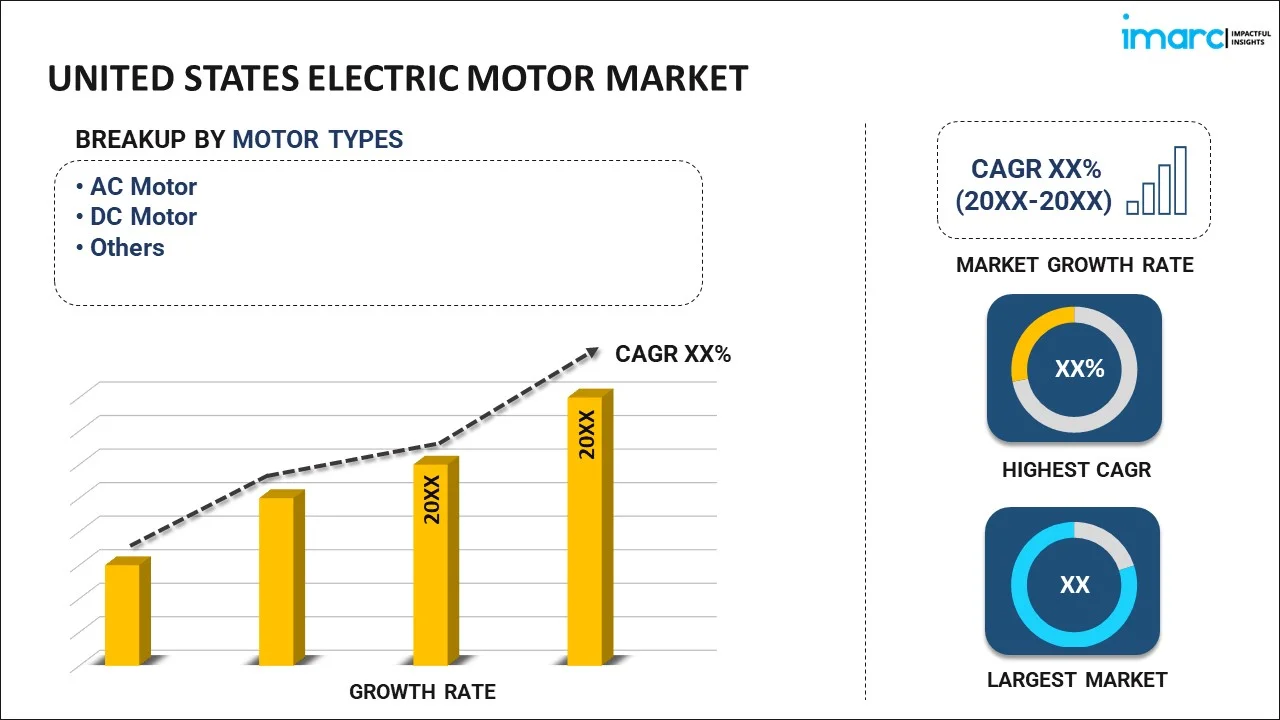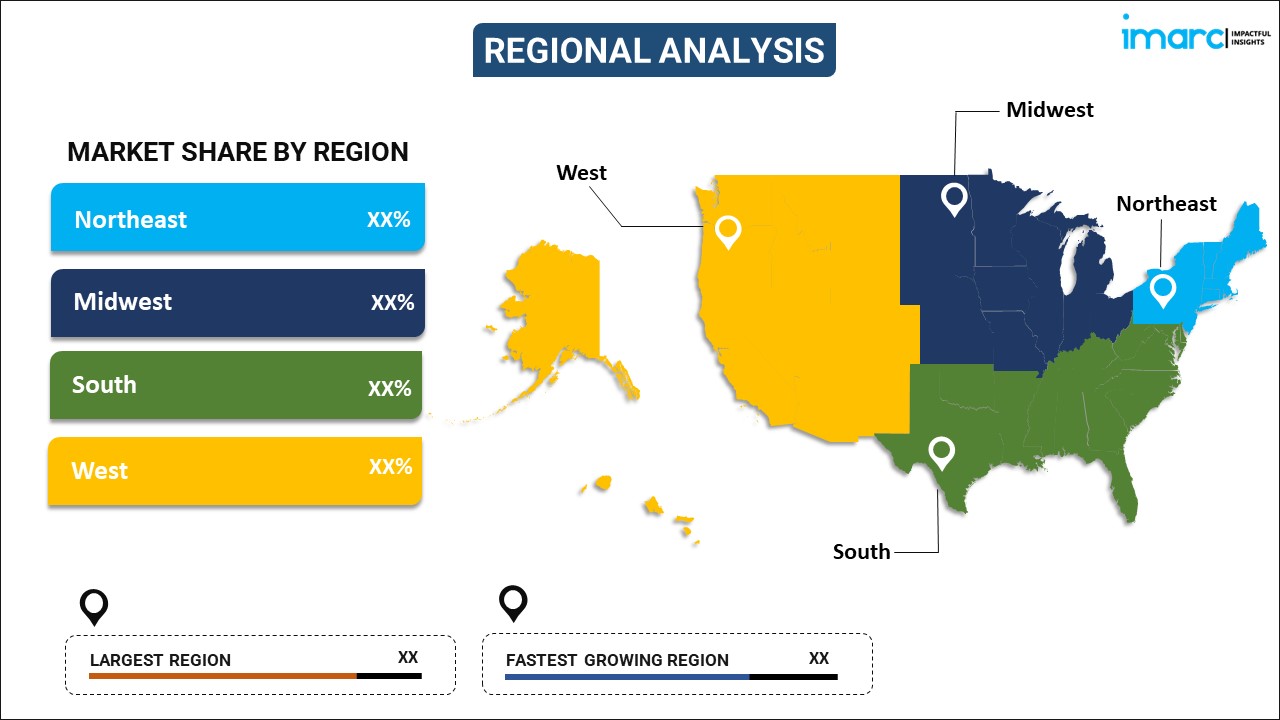
United States Electric Motor Market Report by Motor Type (AC Motor, DC Motor, and Others), Voltage (Low Voltage Electric Motors, Medium Voltage Electric Motors, High Voltage Electric Motors), Rated Power (Fractional Horsepower Motors, Integral Horsepower Motors), Magnet Type (Ferrite, Neodymium (NdFeB), Samarium Cobalt (SmCo5 and Sm2Co17)), Weight (Low Weight Motors, Medium Weight Motors, High Weight Motors), Speed (Ultra-High-Speed Motors, High-Speed Motors, Medium Speed Motors, Low Speed Motors), Application (Industrial Machinery, HVAC, Transportation, Household Appliances, Motor Vehicles, Aerospace, Marine, Robotics, and Others), and Region 2024-2032
Market Overview:
The United States electric motor market size is projected to exhibit a growth rate (CAGR) of 6.40% during 2024-2032. The increasing adoption of electric vehicles, the augmenting product demand in the industrial sector for the manufacturing of machinery and robotics, rising focus on sustainable energy sources, the growth of consumer electronics, and growing smart home technologies are some of the factors propelling the market.
|
Report Attribute
|
Key Statistics
|
|---|---|
|
Base Year
|
2023 |
|
Forecast Years
|
2024-2032 |
|
Historical Years
|
2018-2023
|
| Market Growth Rate (2024-2032) | 6.40% |
An electric motor is a device that converts electrical energy into mechanical energy through the interaction of magnetic fields. It operates based on the principles of electromagnetism, as discovered by Michael Faraday. The fundamental components of an electric motor include a coil of wire (the rotor or armature), a stationary magnetic field (provided by a stator), and a commutator or a set of brushes. When an electric current is applied to the coil within the magnetic field, a force is exerted on the wire, causing it to rotate. This rotational motion is then harnessed for various applications, from powering industrial machinery and electric vehicles to driving fans and appliances in homes. Electric motors are versatile and come in various types, including DC (direct current) motors and AC (alternating current) motors. DC motors are commonly used in applications where a constant and controlled speed is required. In contrast, AC motors are prevalent in situations where variable speeds and high power outputs are necessary. Their role extends from powering household appliances to driving complex machinery in manufacturing and facilitating the propulsion systems of electric vehicles.
United States Electric Motor Market Trends:
The market in the United States is majorly driven by the increasing demand for electric vehicles (EVs). In line with this, the government is implementing stringent emission standards, and consumers are increasingly adopting electric cars to reduce their carbon footprint. This growing shift from traditional internal combustion engines to electric propulsion systems propels the demand for advanced electric motors designed for automotive applications. Furthermore, the rise of industrial automation is contributing to market growth. Industries are embracing automation to improve efficiency, reduce labor costs, and enhance precision in manufacturing processes. Also, the augmenting product demand in the industrial sector for the manufacturing of machinery, robotics, and conveyor systems are acting as a significant growth-inducing factor for the market. Moreover, the growing emphasis on renewable energy sources is catalyzing the market. Additionally, the increasing integration of electric motors in consumer electronics contributes to market expansion. From energy-efficient appliances to HVAC systems and smart home devices, electric motors are essential for various applications in the consumer electronics sector. Besides, rapid advancements in motor technology, particularly in the development of more energy-efficient and compact motors, drive market growth. Manufacturers are investing in research and development to create electric motors with improved efficiency, reduced weight, and enhanced control capabilities. These innovations cater to the evolving needs of industries seeking sustainable and technologically advanced solutions. In the context of smart cities and the Internet of Things (IoT), electric motors contribute to the development of intelligent systems.
United States Electric Motor Market Segmentation:
IMARC Group provides an analysis of the key trends in each segment of the market, along with forecasts at the country level for 2024-2032. Our report has categorized the market based on motor type, voltage, rated power, magnet type, weight, speed, and application.
Motor Type Insights:

- AC Motor
- Induction AC Motor
- Synchronous AC Motor
- DC Motor
- Brushed DC Motor
- Brushless DC Motor
- Others
The report has provided a detailed breakup and analysis of the market based on the motor type. This includes AC motor (induction AC motor and synchronous AC motor), DC motor (brushed DC motor and brushless DC motor), and others.
Voltage Insights:
- Low Voltage Electric Motors
- Medium Voltage Electric Motors
- High Voltage Electric Motors
A detailed breakup and analysis of the market based on the voltage have also been provided in the report. This includes low voltage electric motors, medium voltage electric motors, and high voltage electric motors.
Rated Power Insights:
- Fractional Horsepower Motors
- Fractional Horsepower (< 1/8) Motors
- Fractional Horsepower (1/8 - 1/2) Motors
- Fractional Horsepower (1/2 - 1) Motors
- Integral Horsepower Motors
- Integral Horsepower (1 - 5) Motors
- Integral Horsepower (10 - 50) Motors
- Integral Horsepower (50 - 100) Motors
- Integral Horsepower (>100) Motors
The report has provided a detailed breakup and analysis of the market based on the rated power. This includes fractional horsepower motors (fractional horsepower (< 1/8) motors, fractional horsepower (1/8 - 1/2) motors, and fractional horsepower (1/2 - 1) motors) and integral horsepower motors (integral horsepower (1 - 5) motors, integral horsepower (10 - 50) motors, integral horsepower (50 - 100) motors, and integral horsepower (>100) motors).
Magnet Type Insights:
- Ferrite
- Neodymium (NdFeB)
- Samarium Cobalt (SmCo5 and Sm2Co17)
A detailed breakup and analysis of the market based on the magnet type have also been provided in the report. This includes ferrite, neodymium (NdFeB), and samarium cobalt (SmCo5 and Sm2Co17).
Weight Insights:
- Low Weight Motors
- Medium Weight Motors
- High Weight Motors
The report has provided a detailed breakup and analysis of the market based on the weight. This includes low weight motors, medium weight motors, and high weight motors.
Speed Insights:
- Ultra-High-Speed Motors
- High-Speed Motors
- Medium Speed Motors
- Low Speed Motors
A detailed breakup and analysis of the market based on the speed have also been provided in the report. This includes ultra-high-speed motors, high-speed motors, medium speed motors, and low speed motors.
Application Insights:
- Industrial Machinery
- HVAC
- Transportation
- Household Appliances
- Motor Vehicles
- Aerospace
- Marine
- Robotics
- Others
The report has provided a detailed breakup and analysis of the market based on the application. This includes industrial machinery, HVAC, transportation, household appliances, motor vehicles, aerospace, marine, robotics, and others.
Regional Insights:

- Northeast
- Midwest
- South
- West
The report has also provided a comprehensive analysis of all the major regional markets, which include the Northeast, Midwest, South, and West.
Competitive Landscape:
The market research report has also provided a comprehensive analysis of the competitive landscape in the market. Competitive analysis such as market structure, key player positioning, top winning strategies, competitive dashboard, and company evaluation quadrant has been covered in the report. Also, detailed profiles of all major companies have been provided. Some of the key players include:
- ABB Ltd
- Composite Motors Inc.
- Louis Allis Co.
- Nidec Corporation
- Regal Rexnord Corporation
- Siemens AG
- WEG Industries
(Please note that this is only a partial list of the key players, and the complete list is provided in the report.)
United States Electric Motor Market Report Coverage:
| Report Features | Details |
|---|---|
| Base Year of the Analysis | 2023 |
| Historical Period | 2018-2023 |
| Forecast Period | 2024-2032 |
| Units | US$ Million |
| Scope of the Report | Exploration of Historical Trends and Market Outlook, Industry Catalysts and Challenges, Segment-Wise Historical and Future Market Assessment:
|
| Motor Types Covered |
|
| Voltages Covered | Low Voltage Electric Motors, Medium Voltage Electric Motors, High Voltage Electric Motors |
| Rated Powers Covered |
|
| Magnet Types Covered | Ferrite, Neodymium (NdFeB), Samarium Cobalt (SmCo5 and Sm2Co17) |
| Weights Covered | Low Weight Motors, Medium Weight Motors, High Weight Motors |
| Speeds Covered | Ultra-High-Speed Motors, High-Speed Motors, Medium Speed Motors, Low Speed Motors |
| Applications Covered | Industrial Machinery, HVAC, Transportation, Household Appliances, Motor Vehicles, Aerospace, Marine, Robotics, Others |
| Regions Covered | Northeast, Midwest, South, West |
| Companies Covered | ABB Ltd, Composite Motors Inc., Louis Allis Co., Nidec Corporation, Regal Rexnord Corporation, Siemens AG, WEG Industries, etc. (Please note that this is only a partial list of the key players, and the complete list is provided in the report.) |
| Customization Scope | 10% Free Customization |
| Report Price and Purchase Option | Single User License: US$ 3699 Five User License: US$ 4699 Corporate License: US$ 5699 |
| Post-Sale Analyst Support | 10-12 Weeks |
| Delivery Format | PDF and Excel through Email (We can also provide the editable version of the report in PPT/Word format on special request) |
Key Questions Answered in This Report:
- How has the United States electric motor market performed so far and how will it perform in the coming years?
- What has been the impact of COVID-19 on the United States electric motor market?
- What is the breakup of the United States electric motor market on the basis of motor type?
- What is the breakup of the United States electric motor market on the basis of voltage?
- What is the breakup of the United States electric motor market on the basis of rated power?
- What is the breakup of the United States electric motor market on the basis of magnet type?
- What is the breakup of the United States electric motor market on the basis of weight?
- What is the breakup of the United States electric motor market on the basis of speed?
- What is the breakup of the United States electric motor market on the basis of application?
- What are the various stages in the value chain of the United States electric motor market?
- What are the key driving factors and challenges in the United States electric motor?
- What is the structure of the United States electric motor market and who are the key players?
- What is the degree of competition in the United States electric motor market?
Key Benefits for Stakeholders:
- IMARC’s industry report offers a comprehensive quantitative analysis of various market segments, historical and current market trends, market forecasts, and dynamics of the United States electric motor market from 2018-2032.
- The research report provides the latest information on the market drivers, challenges, and opportunities in the United States electric motor market.
- Porter's five forces analysis assist stakeholders in assessing the impact of new entrants, competitive rivalry, supplier power, buyer power, and the threat of substitution. It helps stakeholders to analyze the level of competition within the United States electric motor industry and its attractiveness.
- Competitive landscape allows stakeholders to understand their competitive environment and provides an insight into the current positions of key players in the market.
Need more help?
- Speak to our experienced analysts for insights on the current market scenarios.
- Include additional segments and countries to customize the report as per your requirement.
- Gain an unparalleled competitive advantage in your domain by understanding how to utilize the report and positively impacting your operations and revenue.
- For further assistance, please connect with our analysts.
 Inquire Before Buying
Inquire Before Buying
 Speak to an Analyst
Speak to an Analyst
 Request Brochure
Request Brochure
 Request Customization
Request Customization




.webp)




.webp)












